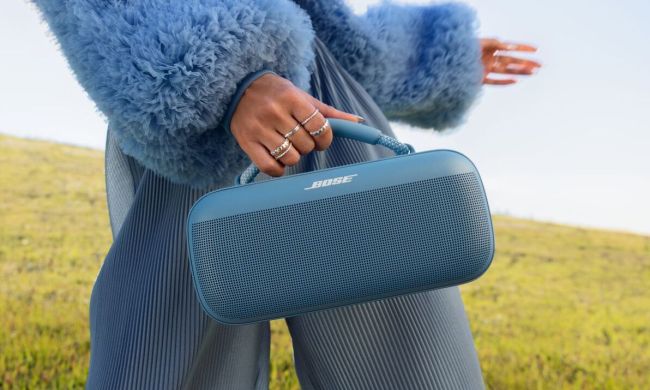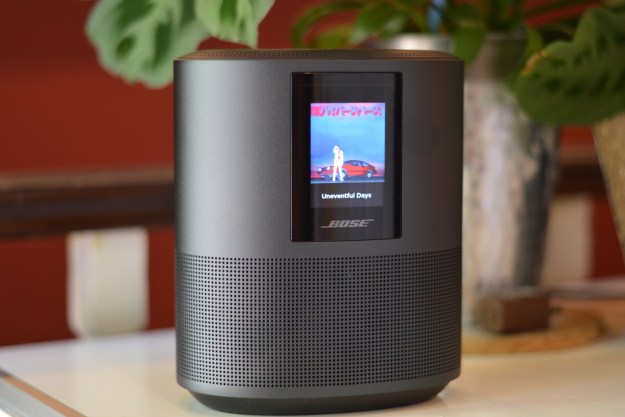
- Expansive stereo sound
- Sleek, attractive design
- Choice of Alexa or Google Assistant
- Easy-to-use controls
- Bluetooth, Wi-Fi, and line-in options
- AirPlay 2
- Expensive
- Some music services not supported
- Slightly awkward multiroom control
- No Chromecast option for Android
In the early days of the smart speaker revolution, finding a speaker that was both smart and had great sound was a challenge. Thankfully, those days are long gone. With products from Sonos, Marshall, Apple, and Amazon, you can now have your cake and eat it too. But before you settle on a new wireless smart speaker from one of those companies, you should consider the $300 Bose Home Speaker 500.
With an intriguing mix of sleek design, expansive sound, and a choice of digital assistants, it could be just the smart audio device your home has been missing.
But is it right for you? Let’s take a look.
Design
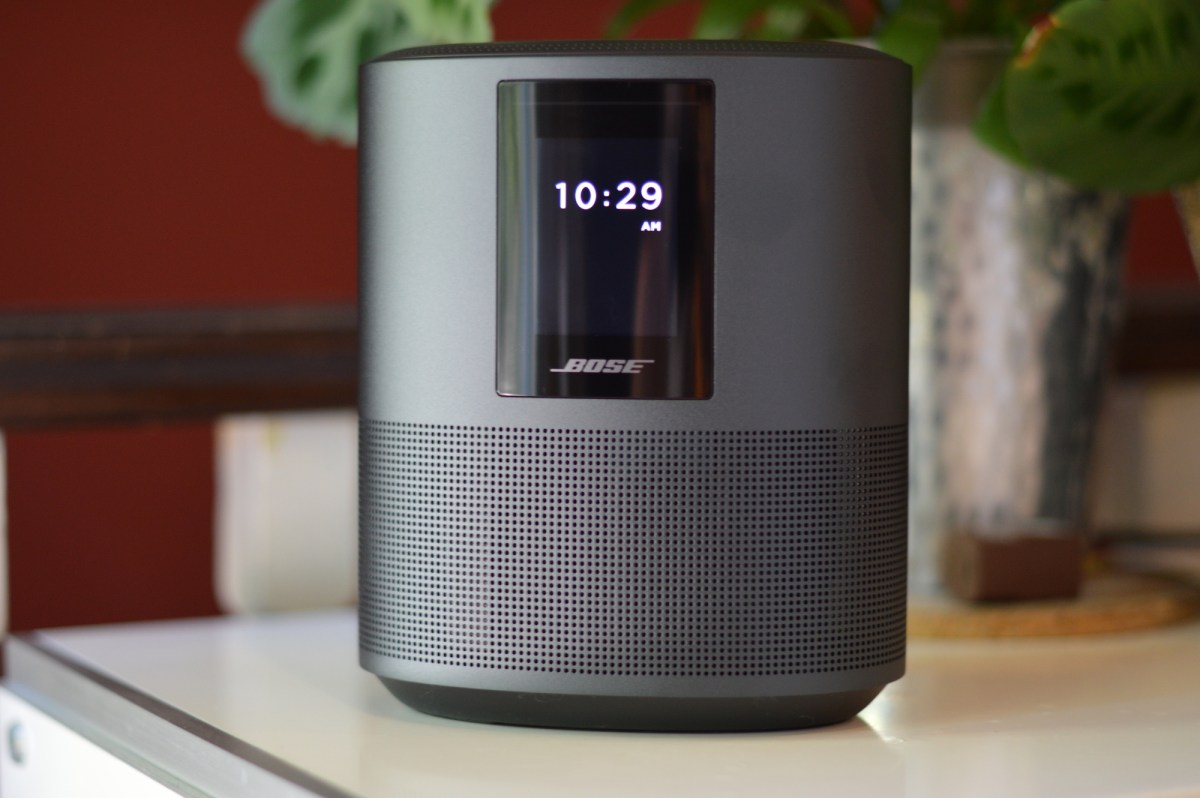
Available in your choice of triple black or a sophisticated two-tone of silver and white, the Bose Home Speaker 500 is deceptively sized. With an elliptical shape that is much wider than it is deep, its base is small enough that it should easily find a perch on a counter-top, bookshelf, or mantle. At just 4.75 pounds It’s also surprisingly light for its size.
Nothing breaks up the speaker’s smooth aluminum and plastic contours — even the included auxiliary input is barely noticeable, hidden on the back near the bottom. My triple black review unit looked great no matter where I placed it.
There are those who are tempted to hide their speakers (even the nice looking ones) where they can be heard but not seen, but that would be a mistake with the Home Speaker 500. Not only would that make it hard to use the thoughtfully designed touch controls that adorn its top surface, but it would also prevent you from seeing its front-facing color screen.
Not that you need to see it, or touch it (it’s not a touch screen), but it just looks so damn cool that it would be a shame not to place it where it can be appreciated.
But I can’t help thinking that Bose has missed an opportunity here. When you’re listening to music, the 3-inch screen displays the album art for the currently playing track, along with the artist and track name. When the speaker is idle, you can choose a clock face or nothing at all, but that’s all it does. I can think of several ways to use that screen: Weather forecasts, news feeds, or even just a choice of gently animating screen savers.
Given that the Home Speaker 500 can also be used a smart speaker, it would be super cool to see the screen used as a secondary display for voice commands, e.g. if you said, “Alexa, what’s the weather like?” and the screen showed you the current weather along with Alexa’s spoken response.
But I digress. Those who like to listen to the same artists, playlists, or radio stations on a regular basis will appreciate the Home Speaker 500’s six dedicated preset buttons. You assign them within the Bose Music app, and they can be associated with almost any music source that the app supports.
Setup
Sonos has always been my benchmark for speedy and simple setups, but Bose is a close second. Using the Bose Music app, I got the Home Speaker 500 configured for my home Wi-Fi, connected to my Google account for Google Assistant access, and happily streaming tunes in under five minutes.
The Bose Music app is easy and for the most part very intuitive to use, with great instructions and feedback at every step.
Connections
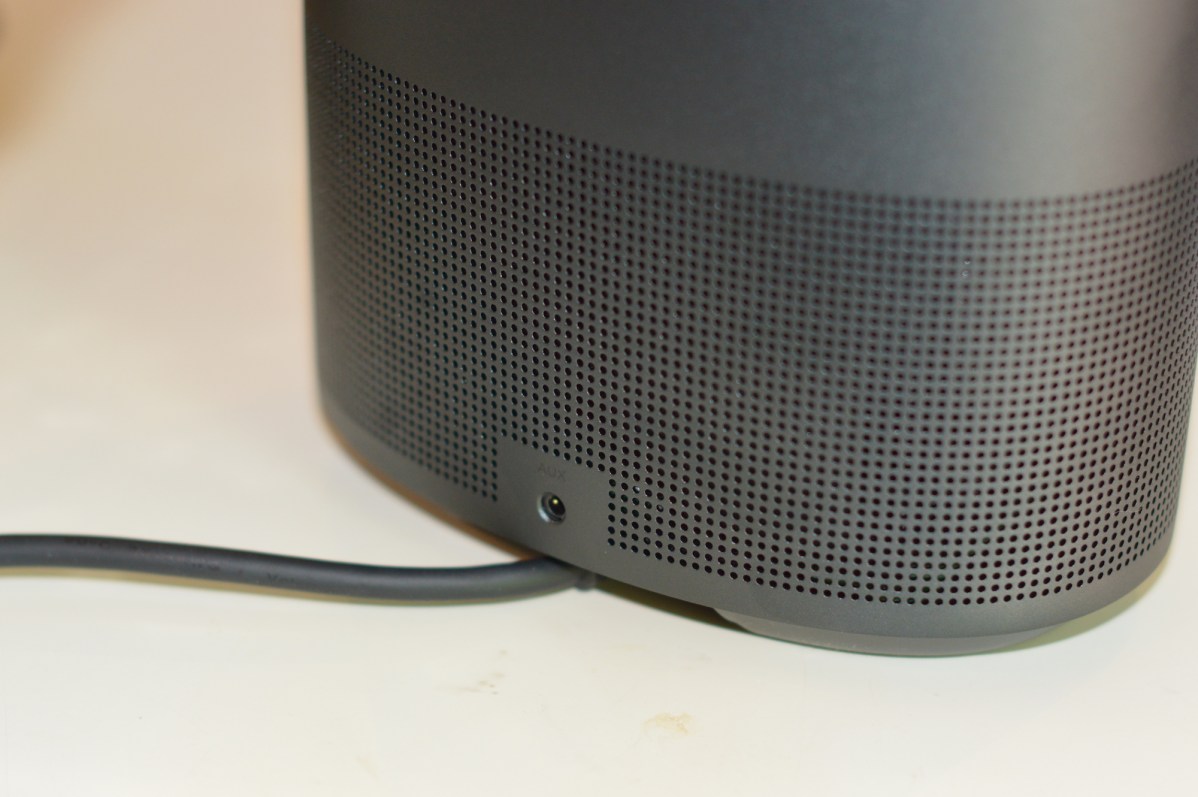
Some home wireless speakers like Sonos only do Wi-Fi, but the Bose Home Speaker 500 gives you three ways to connect: Wi-Fi, Bluetooth, and the line-in input I mentioned earlier. With the exception of a USB port for accessing hard-drive-based files, you can’t ask for more.
However, Bose has opted not to include an ethernet jack, something you might miss if your Wi-Fi network is spotty in places. Sonos includes them on all but one of its speakers, but I suspect very few of their customers use them — I certainly have never needed to.
Wi-Fi, with its higher bandwidth than Bluetooth, should be your connection method of choice, but this is where things get a bit tricky.
Wi-Fi lets you set up and control the Home Speaker 500 from the Bose Music app, and that includes being able to stream music from Spotify Premium and Free, Apple Music, TuneIn, Pandora, SiriusXM, Amazon Music, Deezer, and iHeartRadio. It’s a good selection, but not nearly as comprehensive as that offered by Sonos. Tidal and YouTube Music, for instance, aren’t among the choices. Neither is there any way to stream from a personal music collection on your home network.
If you’re an Apple device owner, AirPlay 2 can go a long way to making up for this shortfall, letting you stream virtually any source of audio from your iPhone, iPad, or Mac, to the Home Speaker 500. But if you’re an Android user who finds the Music app lacking, your only fallback option is Bluetooth.
Chromecast for audio might be a future Wi-Fi path for Android owners, but it’s not supported yet on the Home Speaker 500. When it does show up, it will be as a subset of the Google Assistant, so those who prefer Alexa — or no assistant at all — will still be stuck with Bluetooth.
Sound quality
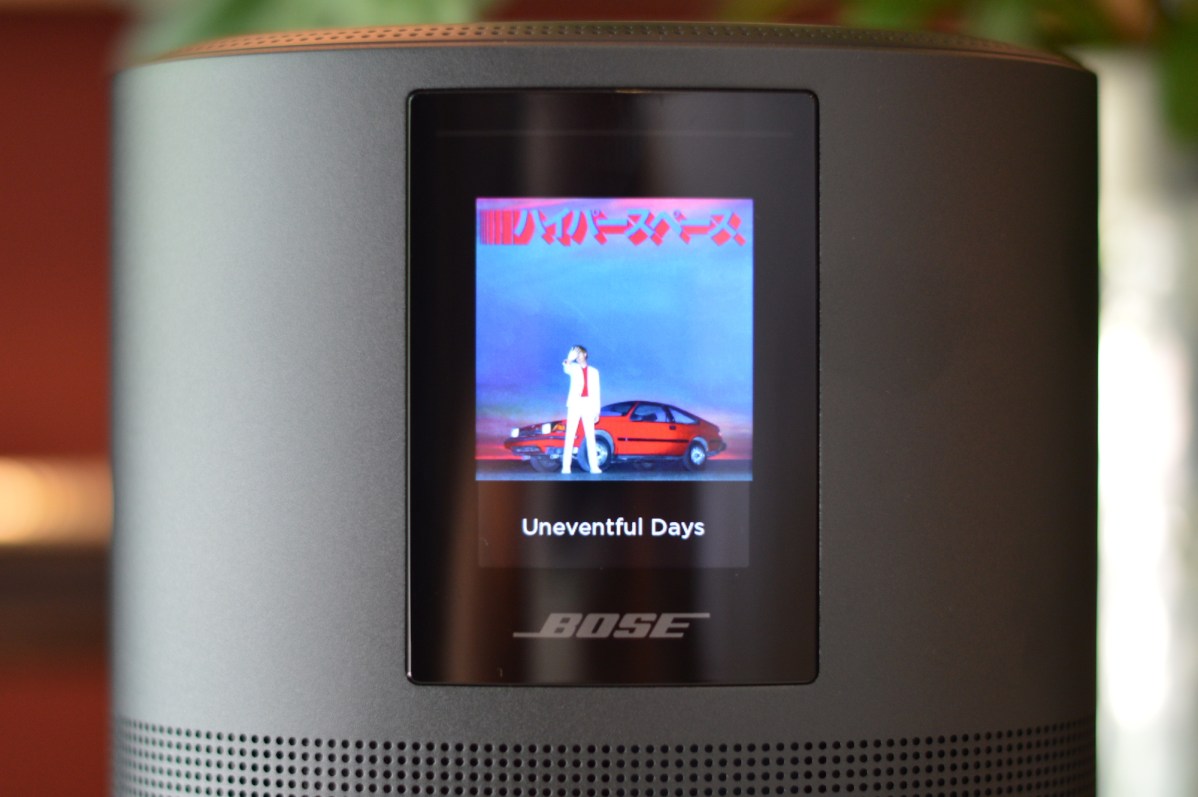
Bose makes a pretty big claim for the Home Speaker 500: “The widest sound of any smart speaker.” I put it side-by-side with the $200 Amazon Echo Studio, which has a very similar internal driver layout and both products are designed to offer immersive sound. The Home Speaker 500 performed admirably, delivering a slightly wider soundstage than the Echo Studio, despite having weaker bass response.
Just how expansive the sound gets is in part affected by placement. In an ideal world, you would give it lots of breathing room, away from walls and preferably not tucked into a bookshelf.
Widest or not, I think you’ll love the way this speaker sounds. Bose has positioned the internal drivers in such a way that sound waves are dispersed in a kind of lopsided 360-degree field. By that I mean the best seat in the house is sitting directly in front of the speaker, but you’ll still be able to enjoy about 80% of its full quality from almost anywhere else.
It’s an effect I learned to appreciate when reviewing Bose’s excellent Portable Home Speaker, which produces an almost perfectly circular sound field.
What’s impressive is that not only do you get genuine room-filling audio, but you also get some pretty decent stereo separation — not an easy feat for a speaker this small.
You can tweak both bass and treble from within the app, but unless your tastes run really strong in one of those directions, the factory EQ delivers a pleasing balance of both.
If there’s a weakness, it’s in the midrange definition — a challenging area for even the best small speakers. It’s most noticeable when playing genres like classical or jazz — instruments that live in the middle frequencies like cellos, and some woodwinds, can get a bit flattened. But overall, the Home Speaker 500 is a joy to listen to, whether it’s providing the backdrop to an intimate dinner or a raucous get-together.
The Home Speaker 500 is also capable of some downright impressive volume levels. Max this thing out and be prepared for plenty of knocks on the door from irritated neighbors.
Multiroom audio
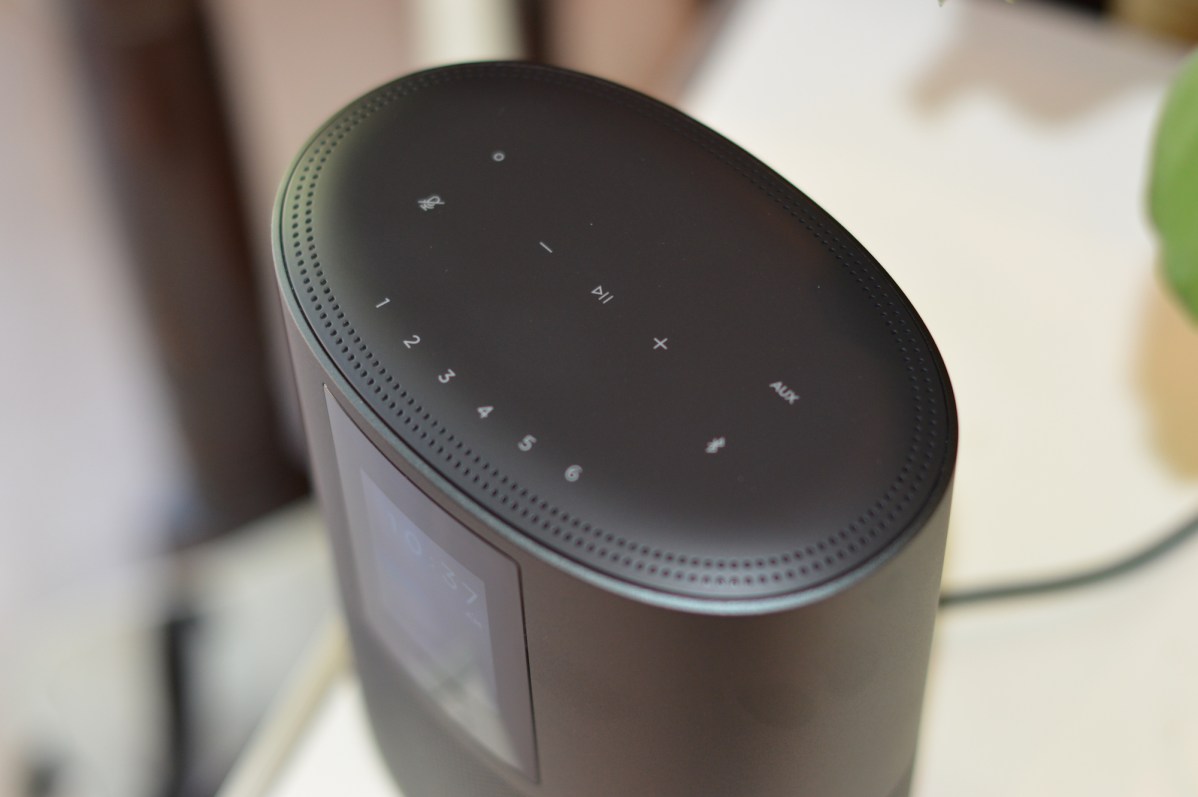
One of the benefits of buying a wireless speaker for the home is being able to play different music in each room, or the same music in all rooms (or some combination thereof). The Home Speaker 500 can easily be grouped with other Bose Home speakers, like the Home Speaker 300, or the Bose Soundbar 500, via the Bose Music app.
However, using multiroom requires a bit of planning. Because you can also create speaker groups using AirPlay 2, you need to decide whether you plan to stream from a music service within the Bose Music app — in which case you would manage your speaker groups there — or, from another app on your phone or tablet — in which case you would manage the groups using the AirPlay 2 interface.
The two systems don’t play well with each other; groups created in the Bose Music app don’t like it when you try to modify them using AirPlay 2 or vice versa.
There’s also no way to create stereo pairs using two Bose speakers. If multiroom audio is a top priority, I think you’ll be happier with Sonos.
However, Bose does have one trick up its sleeve that I haven’t encountered on any wireless speaker system, including Sonos. Bose calls it Simplesync, and it lets you group any Bluetooth audio device, from a portable speaker to a set of wireless headphones, with the Home Speaker 500. Bose says this feature works best with the company’s own Bluetooth speakers and headphones, in the sense that audio will be more accurately synced.
It’s true. I tried Simplesync with a JBL Flip 5 speaker I had on hand, and while setup was a snap, there was some split-second latency between the two speakers. I wouldn’t rely on it for doing multiroom audio, but it’s a pretty handy option.
Voice assistants
Bose has followed Sonos’ lead on its smart speaker strategy, and that’s an excellent decision. Like Sonos, Bose lets you choose between Alexa and Google Assistant on the Home Speaker 500 instead of selling two different versions of the speaker as other home audio companies have done.
I chose Google Assistant for this review because I have more compatible products in my home, but it’s just as easy to set up the Home Speaker 500 with Alexa. Bose has really nailed the smart speaker experience. Voice commands are recognized effortlessly even in fairly loud environments, and from distances as far as 15 feet without needing to really raise your voice. If privacy is a concern, a dedicated microphone-mute button guarantees an A.I.-free environment.
Response times are also very good; I didn’t notice any difference between the Home Speaker 500 and my Google Nest mini in terms of reaction times.
I especially liked that the glowing white LED strip above the color screen provided instant visual feedback that my commands had been heard. Most smart speakers have a similar visual cue, but if they’re only visible from the top surface (like Sonos smart speakers or Google’s Home and Nest minis) you can’t see them as easily from across a room.
There is one caveat if you’re picking the Bose Home Speaker 500 to be your smart speaker, and that’s music service compatibility. Even though Google Assistant and Alexa can take control of a variety of music services, if the Home Speaker 500 doesn’t support a specific service (see above, under Connections), you won’t be able to use these voice assistants to control it. Google Play Music (now mostly transitioned to YouTube Music), Apple Music, and Tidal are all examples of services that can’t be voice-controlled by either assistant on the Home Speaker 500.
Our take
At its new lower price of $300, the Bose Home Speaker 500 costs the same as the Apple HomePod and Google Home Max, two very good smart speakers. But with Bluetooth, line-in, a full-color display, and your choice of voice assistants, it delivers more value than both of these products and sounds amazing too.
Is there a better alternative?
For $200, the Sonos One delivers superb sound and supports nearly every streaming service on the planet. It doesn’t have the Home Speaker 500’s ultra-wide stereo soundstage, Bluetooth, auxiliary input, or fancy color screen, but it has the best multiroom audio system we’ve ever used. It’s still our top-rated smart speaker for a reason.
If you’re on board with Bose’s take on the smart speaker experience but would prefer to pay a little less, the $200 Bose Home Speaker 300 loses the color screen and wide, stereo sound but keeps every other feature.
How long will it last?
Bose builds great products that typically last a long time. It only covers the Home Speaker 500 with a one-year warranty, though this is fairly standard for similar products from other companies.
Should you buy it?
Yes. The Bose Home Speaker 500 combines gorgeous design with voice assistant flexibility and an expansive stereo sound that is remarkable for its slender body. The color screen is a nice touch too. Android users should be aware of the lack of Chromecast as a Wi-Fi streaming option, but Apple users should be more than happy with AirPlay 2 as a Bluetooth alternative.


